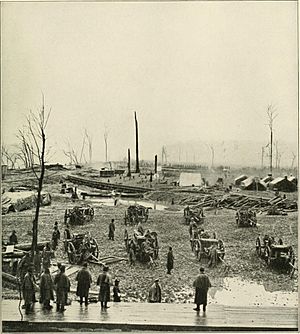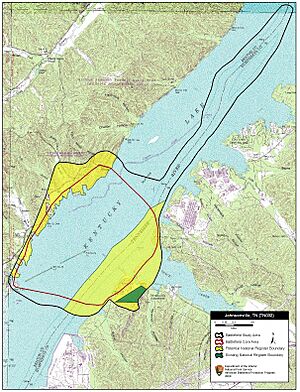Battle of Johnsonville facts for kids
Quick facts for kids Battle of Johnsonville |
|||||||
|---|---|---|---|---|---|---|---|
| Part of the American Civil War | |||||||
|
|||||||
| Belligerents | |||||||
| Commanders and leaders | |||||||
| Charles R. Thompson Edward M. King |
Nathan Bedford Forrest | ||||||
| Units involved | |||||||
| Johnsonville garrison | Forrest's Cavalry Division | ||||||
| Strength | |||||||
| 4,000 3 gunboats |
|||||||
| Casualties and losses | |||||||
| 150 captured | 2 killed 9 wounded |
||||||
The Battle of Johnsonville was a fight during the American Civil War. It happened on November 4–5, 1864, in Tennessee. A Confederate cavalry leader, Nathan Bedford Forrest, attacked a Union supply base. This base was located at Johnsonville.
Forrest's attack destroyed many Union boats and supplies. This made it harder for Union Major General George Henry Thomas to get supplies. His army was trying to stop a Confederate invasion of Tennessee. Even with these problems, Thomas eventually pushed back the Confederate army.
Part of the battlefield is now a state park. Much of the original battle area is now under Kentucky Lake. This lake was created in 1944.
Contents
Why Was Johnsonville Important?
The Union army used the Tennessee River to move supplies. These supplies were for their soldiers in Tennessee. They would unload goods at Johnsonville. Then, they sent them by train to Nashville. In 1864, these supplies were mostly for General Thomas's army.
At the same time, a Confederate army under John Bell Hood was planning to invade Tennessee. Hood hoped to cut off Union supply lines. He wanted to force Union General William Tecumseh Sherman into a big battle. Sherman decided not to chase Hood. Instead, he marched his army through Georgia. He destroyed supplies and railroads there. General Thomas was left in charge of defending Tennessee.
Forrest's Plan to Attack
Confederate General Richard Taylor ordered Forrest to raid western Tennessee. Forrest's goal was to destroy the Union supply route to Nashville. His first target was Fort Heiman. This fort was on the Tennessee River, north of Johnsonville. Taking it would stop Union boats from reaching Johnsonville.
Forrest's men started their raid on October 16, 1864. They were tired from a previous mission. Forrest told them to get new horses and supplies. Then, they rejoined the raid. Forrest moved north on October 24. He reached Fort Heiman on October 28. There, he set up his cannons.
On October 29 and 30, Forrest's cannons helped capture three Union boats. These were the Mazeppa, Anna, and Venus. They also captured a gunboat called the Undine. After this, the Union stopped sending supplies upriver to Johnsonville.
Forrest fixed two of the captured boats, Undine and Venus. He planned to use them in his attack on Johnsonville. The boats and his cavalry started moving on November 1, 1864. His foot soldiers had trouble on the roads. Recent rains made the roads very muddy.
On November 2, two Union gunboats, Key West and Tawah, challenged Forrest's boats. The Venus got stuck and was captured. The Union sent six more gunboats from Paducah, Kentucky. On November 3, these boats fought with Confederate cannons. The cannons were set up near Johnsonville. The Union fleet had trouble fighting these positions. This gave Forrest time to get ready for his attack.
The Battle Begins
On the evening of November 3, 1864, Forrest's cannon expert, Captain John Morton, placed his guns. They were across the river from the Union supply base at Johnsonville. On the morning of November 4, the Undine and Confederate cannons were attacked. Three Union gunboats from Johnsonville fired at them. Six more Union gunboats from Paducah also joined the fight.
Captain Frank M. Gracey, a Confederate cavalryman, left the Undine. He set it on fire. Its ammunition exploded. This ended Forrest's short time as a naval commander. Even with this loss, the Confederate cannons on land were very effective. They stopped the Union gunboats. The Union commander from Paducah was careful. He did not want to take his gunboats through the narrow river channel. He kept them firing from a distance. The Union gunboats from Johnsonville were hit many times. They had to go back to Johnsonville.
Captain Morton's cannons then fired at the Union supply depot. They also shot at the 28 steamboats and barges at the dock. All three Union gunboats, the Key West, Tawah, and Elfin, were damaged or destroyed. The Union commander at Johnsonville ordered the supply boats to be burned. He did not want the Confederates to capture them.
Forrest watched the scene. He later wrote, "By night the wharf for nearly one mile up and down the river presented one solid sheet of flame." After finishing his mission, Forrest moved his troops away. They marched by the light of the burning Union property.
What Happened After the Battle?
Forrest caused a lot of damage with very few losses. He reported only 2 men killed and 9 wounded. He said the Union lost 4 gunboats, 14 transport ships, 20 barges, and 26 cannons. He also claimed $6.7 million worth of property was destroyed. About 150 Union soldiers were captured. One Union officer estimated the loss at about $2.2 million.
This raid also made Union leaders worried. They were concerned about Sherman's plan to march through Georgia. They thought he should fight Hood and Forrest directly. Forrest's troops were slowed by heavy rains. They eventually reached Corinth, Mississippi, on November 10, 1864.
During Forrest's raid, on November 3, Confederate General P. G. T. Beauregard ordered Forrest's cavalry to join Hood's army. Hood waited to start his invasion of Tennessee. He wanted to meet with Forrest first. Forrest and his forces arrived on November 16.
Johnsonville Today
The Battle of Johnsonville is now remembered at two Tennessee state parks. Nathan Bedford Forrest State Park is on the Benton County side of the river. Johnsonville State Historic Park is on the Humphreys County side. The American Battlefield Trust has helped save about 19 acres (0.077 km²) of the battlefield.
Much of the historic battlefield is now under Kentucky Lake. This large, man-made lake was created in 1944. The Tennessee Valley Authority (TVA) built a dam on the Tennessee River. This was for flood control. The lake area is also a popular place for fun activities.



